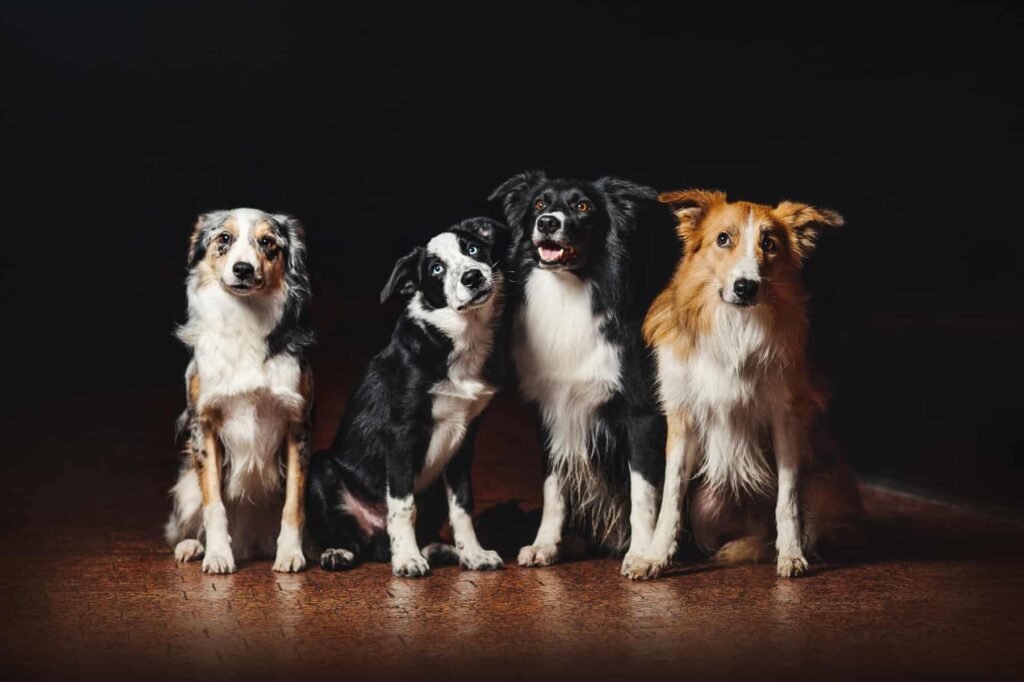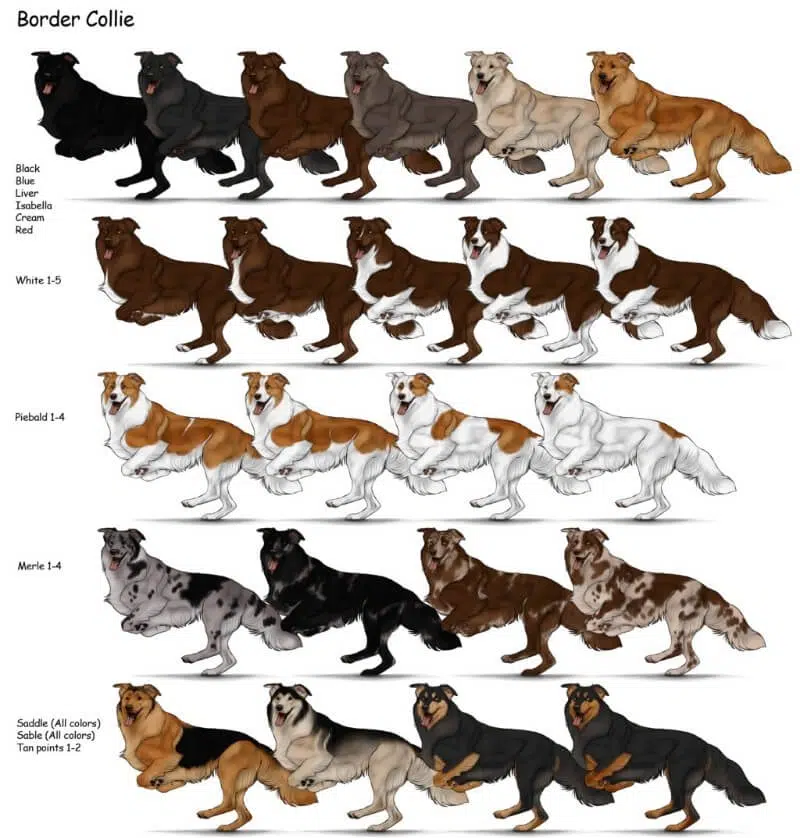Have you ever wondered why some Border Collies have such unique and distinct coat colors? It’s fascinating how these dogs can come in a variety of different shades and patterns, isn’t it? Well, in this article, we’re going to dive deep into the world of Border Collie color variations and explore the reasons behind these beautiful coat patterns. So if you’re a Border Collie enthusiast or simply curious about canine genetics, grab a cup of coffee and get ready to learn more!
Let’s start by talking about the most common coat colors you’ll find in Border Collies. While black and white may be the classic combination that comes to mind, these dogs also come in various other shades such as red, blue, brindle, and even merle. The color patterns can range from solid to spotted, and some Collies may even have a tri-color coat. The wide range of colors is a result of the genetics and breeding practices that have been employed to develop the breed over the years. In this article, we’ll take a closer look at the different color genetics involved and explore how these variations come about. So, whether you’re a potential owner looking to choose a Collie with a specific color or simply interested in the science behind it all, we’ve got you covered!

The Importance of Color in Border Collies
When it comes to Border Collies, one of the first things that catches everyone’s attention is their beautiful and unique coat colors. The diversity in colors is not only aesthetically pleasing, but it also serves as an important identifier for these intelligent and hardworking dogs. Understanding the different color variations in Border Collies can help potential owners choose the perfect companion that matches their preferences and lifestyle.
The Main Color Patterns in Border Collies
Border Collies can have a variety of color patterns, each with its own unique characteristics. The most common color patterns include black and white, black and tan, red and white, blue and white, merle, tricolor, sable, and brindle. Let’s explore each of these patterns in detail.
Black and White Border Collies
Black and white Border Collies are perhaps the most recognized and iconic color variation. These dogs have a primarily black coat with distinctive white markings on their chest, face, and legs. The contrast between the black and white creates a striking appearance that is instantly recognizable.
Black and Tan Border Collies
Black and tan Border Collies are another popular color variation. These dogs have a base coat of black, with tan markings on their eyebrows, cheeks, legs, and tail. The tan color usually forms distinct points, adding an elegant touch to their overall appearance.
Red and White Border Collies
Red and white Border Collies are known for their vibrant and eye-catching coats. These dogs have a reddish-brown base coat with white markings. The red color can vary in intensity, ranging from a deep mahogany to a lighter copper shade.
Blue and White Border Collies
Blue and white Border Collies exhibit a stunning color combination that is highly sought after. The blue color is a dilution of black, resulting in a bluish-gray coat. Similar to black and white Border Collies, these dogs have prominent white markings, creating a beautiful contrast.
Merle Border Collies
Merle is a unique and visually striking color pattern found in Border Collies. Merle dogs have a marbled coat with patches of colors, creating a mesmerizing effect. The base color can be any shade, combined with patches of lighter or darker shades of the same color or different colors altogether.
Tricolor Border Collies
Tricolor Border Collies feature a tri-color coat composed of three distinct colors. The base color is usually black or blue, with tan markings on the eyebrows, cheeks, legs, chest, and under the tail. The third color is typically white, forming the classic tricolor combination.
Sable Border Collies
Sable Border Collies have a unique coat pattern characterized by individual hairs having bands of different colors. This results in a beautiful blend of colors that can range from light to dark, creating a captivating effect. Sable dogs often have a dark face mask and may exhibit other color variations such as white markings.
Brindle Border Collies
Brindle Border Collies are less common but equally mesmerizing. Brindle refers to a pattern of alternating dark and light stripes on a dog’s coat. The base color can be black, blue, or another dark shade, while the brindle pattern appears as lighter stripes. These dogs often have white markings as well, adding to their distinctive appearance.

The Role of Genetics in Border Collie Colors
The fascinating array of color variations in Border Collies can be attributed to genetics. Genes play a significant role in determining a dog’s coat color and pattern. Different combinations of genes result in the unique color variations seen within the breed.
Coat color in Border Collies is primarily influenced by two pigments – eumelanin and pheomelanin. Eumelanin is responsible for black and brown colors, while pheomelanin produces red and yellow colors. The interaction between these pigments, along with other genetic factors, determines the specific coat colors observed in Border Collies.
The Agouti gene, for example, influences the distribution of black and brown pigments, leading to variations in coat patterns. Other genes can affect dilution, intensity, and pattern formation, resulting in the diverse range of colors seen in Border Collies.

Factors Influencing Border Collie Color Variations
Apart from genetics, there are several factors that can influence the color variations in Border Collies. These factors include the presence of certain alleles, the expression of specific genes, and environmental influences.
Some alleles carry instructions for specific coat colors or patterns and can be passed down from parent dogs to their offspring. The combination of alleles inherited from both parents can result in a wide range of color possibilities.
The expression of certain genes can also influence the final coat color. Genes associated with pigment production and distribution can determine the intensity, distribution, and pattern of colors in a dog’s coat.
Additionally, environmental factors such as sun exposure and aging can cause changes in coat color over time. Sun bleaching, for example, can lighten the coat, while gray hairs may appear as a dog ages.

Recognized and Non-Recognized Color Variations
When it comes to Border Collies, there are color variations that are officially recognized by kennel clubs and breed standards, and there are those that are considered non-standard or non-recognized.
Recognized color variations are those that adhere to the breed standards and are commonly seen in purebred Border Collies. Examples of recognized color variations include black and white, black and tan, red and white, and blue and white.
Non-recognized color variations, on the other hand, deviate from the breed standards and are less commonly seen. These variations may result from genetic mutations or combinations that are not typical for the breed. While they may not be considered standard, they can still be found in Border Collies and are just as unique and lovable.

Maintaining Healthy Border Collie Colors
While coat color is an exciting aspect of Border Collies, it’s important to prioritize the overall health and well-being of these magnificent dogs. Maintaining healthy and vibrant colors can be achieved through proper nutrition, grooming, and care.
A balanced diet is essential for keeping a Border Collie’s coat in optimal condition. High-quality dog food that provides all the necessary nutrients, including vitamins and minerals, can help promote a healthy coat. Regular grooming, including brushing and bathing, will also contribute to a shiny and well-maintained coat.
Protection from the elements, especially the sun, is crucial for preventing the fading or bleaching of a Border Collie’s coat. Providing shade and using sunscreen formulated for dogs can help prevent damage from sun exposure.
Regular veterinary check-ups are also vital for ensuring the overall health of a Border Collie. A veterinarian can monitor any changes in coat color or texture that may indicate underlying health issues.
In conclusion, understanding the various color variations in Border Collies adds to the appreciation of this remarkable breed. From the traditional black and white to the unique combinations of merle and brindle, each color pattern exhibits its own charm and allure. Whether a Border Collie’s coat adheres to recognized standards or deviates from the norm, what matters most is the love and companionship these dogs bring into our lives. So, whether you prefer a classic black and white beauty or an unconventional color variant, a Border Collie will undoubtedly be a loyal and loving companion.